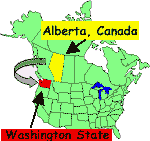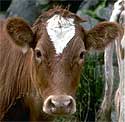By
Ellen Kuwana
Neuroscience for Kids Staff Writer
January 5,
2004
 In response to the December 2003 confirmation of "mad cow disease" (BSE) in a Holstein cow, the US
Department of Agriculture (USDA) announced several changes to the way
cows are slaughtered: In response to the December 2003 confirmation of "mad cow disease" (BSE) in a Holstein cow, the US
Department of Agriculture (USDA) announced several changes to the way
cows are slaughtered:
- "Downer" cattle, usually older animals who are sick and cannot
walk, will no longer be permitted to enter the human food supply. The USDA
estimates that in 1999, 195,000 downer cattle were slaughtered. In the
past, one out of every 10 downer animals was tested for BSE, and the meat
from downer cattle could be processed before test results came
back. Thus, the meat from the infected Holstein cow, slaughtered on
December 9, 2003, was processed and shipped for human consumption. About
80% of that batch went to Washington state and Oregon; the rest was sent
to Nevada, California, Montana, Idaho, Alaska, Hawaii and Guam. On
December 23, 2003, the USDA issued a voluntary recall of the 10,000 pounds
of beef; it is unknown how much of it has already been consumed.

- Certain cow parts which are believed to be infectious if a cow has BSE
(the USDA refers to these parts as "Specified Risk Material") are now
prohibited from the human food supply. These include skull, brain,
trigeminal ganglia, eyes, vertebral column, spinal cord and dorsal root
ganglia from cattle older than 30 months (3-6 years is believed to be the
incubation period of the disease). The small intestine from cattle of all
ages is also prohibited.
- Air-injection stunning is now prohibited. Air forcibly injected into
the cow's skull stuns it unconscious before it is slaughtered; the concern
is that brain tissue could gain access to the bloodstream, thus
contaminating the meat.
- Some of the ways in which meat is recovered from the carcass are being
limited because they may contaminate the meat with bone fragments or
central nervous system tissue. Technology called Advanced Meat
Recovery uses high pressure jets of water to remove muscle tissue from
the bone. The USDA now requires verification to ensure that spinal cord or
dorsal root ganglia is not present in the meat recovered by this process.
The machines can strip meat from the carcass faster and recover more meat
than a person working by hand with a knife. This translates to more
profits, but the machines cannot tell when too much pressure is used
and bone and nervous system tissue are stripped from the carcass. Many
processors are phasing out use of Advanced Meat Recovery, betting that
consumer confidence in the meat supply is more important than recovering
every last scrap of meat. McDonald's and General Mills, for example, have
announced that they will not use meat recovered in this manner.
- Mechanically separated meat is prohibited from use in human
food.
Other Changes Announced by USDA
- The USDA is looking into using a much faster test for BSE, one
that takes 3 days, not 1-2 weeks to get an answer. These tests are already
used in Europe and Japan. Using this faster test, a downer cow could be
tested and the carcass held for a few days until the test result cleared
it for processing. This is being referred to as "test and hold." Testing
requires killing the cow and taking a sample from the brain stem. Many
food safety advocates are calling for more widespread testing. Japan
currently tests every cow that will be eaten in Japan. In the past three
years of testing of every single cow destined for human consumption, 9
cows have tested positive for BSE out of 1.2 million cows screened yearly.
The youngest cow with BSE was 21 months. European countries start checking
for BSE in cattle who are 24 months and older. The US starts testing at
30 months and in the past 13 years has screened 57,000 animals out of the
390 million slaughtered. The USDA plans to double the number of downed
cows tested for BSE, bringing the number from 20,000 in 2003 up to 40,000
in 2004.
- A nationwide electronic tracking system will allow for quicker tracing
if another case of BSE is detected. This will also make determining the
age of cattle more accurate and easy. The plan proposes to have farms assigned
identification
numbers by July of 2004 and for every cow to have an assigned ear tag ID
number by July of 2005.

Tracing the Infected Cow The infected cow found in Washington
state was born in Alberta, Canada, in April of 1997. One other case of BSE
was reported in Alberta, Canada, in May of 2003. This suggests that the
two infected cows may have been from the same herd, pointing toward feed
as the source of the disease. An investigation found that the cow is
six-and-a-half years old. She was brought to the US with about 80 other
dairy cows (23 have been located so far) in 2001. Her age is significant
because it means that she was born a few months before
Canada and the US banned the use of cow tissue in cattle feed. The US
imports many cattle from Canada. In 2002, 1.7 million cattle were imported
from Canada by the US.
These changes address concerns about the safety of beef in the US, which
has been banned by approximately 45 countries so far. About 10% of US beef
is exported each year, totaling more than 2.6 billion dollars.
|


![[email]](./gif/menue.gif)



